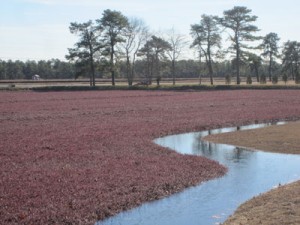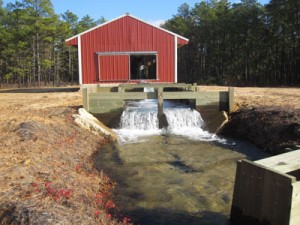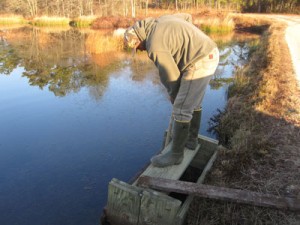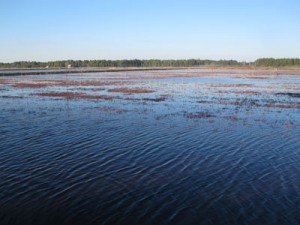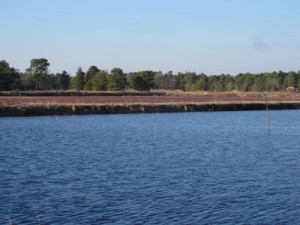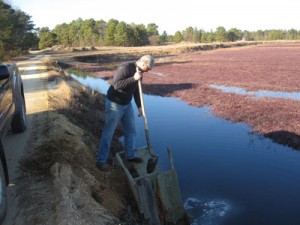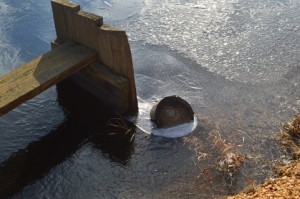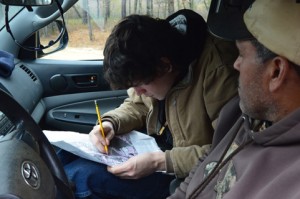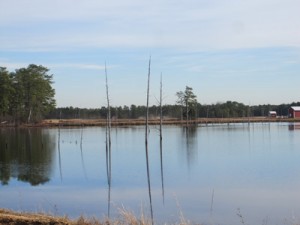The cranberry growing season lasts from April to November; the fruiting buds mature during the winter dormancy period. During the dormant season, severe winter weather could harm or even kill cranberry vines, which is why growers must take preventative measures to protect their crop. When harvest ends, cranberry growers everywhere start their winter flooding. Under normal conditions, the temperature steadily drops post-harvest; it is important to wait until the vines go dormant before starting to put the water on. When vines go dormant, they turn burgundy in color:
Our winter flood program starts with making sure the water in the reservoirs is at the necessary levels. If there has no been significant rain to get the reservoirs to flooding level, we start our wells. We will continue to use the wells to maintain the reservoirs and the stream needed to get the bogs flooded.
The next step is placing boards in the gates to start bringing the water level up in the bogs, much like we do to prep for the flooding at harvest in the fall. The late Bill Sr.’s favorite maxim about just about everything involving cranberries was, “Where is the water coming from, and where do you want it to go?” That can be one of the most challenging things to pick up when you are learning about Pine Island’s system. Manager of Operations Matt Giberson agrees: “There’s a lot to know. How the water works, how to move it the most efficient way. We don’t learn how to do this overnight; I’m still learning new things about it every year.” In practice, this means constant awareness and monitoring of where the water is coming from, where it is going, and how much stream is coming down.
Flooding starts by letting in streams from the reservoirs to canals and bogs. Strategic board placement (more boards in the southernmost bogs to catch the water) will get the ditches high and running down to start flooding from the bottom up.
As the water level in the bogs begins to rise, our team begins adjusting the water level in the bogs by adding boards where they are needed. Once the vines are covered and the stream has settled, we adjust the level of the reservoirs to maintain the stream and keep the bogs flooded for the winter. Wells are shut down once bogs are flooded, and only turned on again if it is dry and reservoir levels are dropping.
It is also necessary to make sure we are not losing water anywhere. “Sometimes you can hear the water coming through a gate that’s supposed to hold it,” Matt says. “It’s the same as running diesel fuel; it’s a big waste, and we need to try to stop it or slow it down.” He does this by adding sand or even grass in front of the leaking boards, as sometimes the sand can wash away too quickly.
Once we are flooded, our team needs to constantly monitor the bogs to make sure there are no leaks, that the water level remains steady, and that the stream remains constant. The weather is also a factor: no rain for a long period of time will shrink the reservoirs and wells may need to be started to maintain the water level in the bogs. Matt says, “If it gets cold enough for the water to freeze, I also need to check to see if I have to break any ice to keep the stream flowing, especially on the southeast gates.”
This year, Jeremy Fenstermaker is training Matt Stiles on the flood process, and Mike Haines continues to learn about it as well. “Both Matt and Mike are getting a handle on what we’re doing as well as understanding why we’re doing it,” Jeremy says. “Mike’s had a couple more years than Matt, but Matt’s learned a lot this year just from running a harvest crew.” He also says communication is everything, because “an action in one section will have a huge effect somewhere else. It’s important to learn the whole process but it’s even more important to know how it all ties together. But Matt and Mike are eager learners and pick things up fast.”
Once the winter flood is done, our team maintains reservoirs throughout the whole winter. The Ox Pasture reservoir, for example, has to stay high so our team doesn’t have to run the well. This is important because Ox Pasture, situated at the northernmost end of the property, is Pine Island’s largest reservoir and the primary source of water for the home farm.
Putting on the winter flood as quickly and efficiently as possible saves time, fuel, and most importantly, protects next year’s crop. It is this attention to the environment and continuous improvement of our processes that help us grow more acres and more fruit per acre with every successive year.

